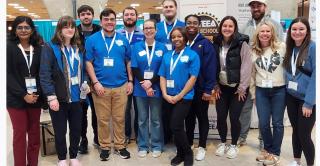
By Amy J. Barry
In most industries, the best prepared professionals know how to think outside the box — or at least the textbook.
In a field like transportation, experiential learning is as critical to the job as a firm understanding of theory and best practices.
Two Central alumni — Domenic LaRosa ’90 and Matthew Cleary ’94 — say they got the best of both worlds at Central. When they acquired jobs at the Connecticut Department of Transportation, they say their education at Central positioned them well to work their way up the ranks. They now run ConnDOT’s District 3, the biggest district in the state, which covers New Haven County to the New York border.
LaRosa, a district engineer, and Cleary, an assistant district engineer, each hold a BS in Engineering Technology. They have been at the DOT for 29 and 25 years respectively, but didn’t meet until four years ago when Cleary was promoted to his current position.
Although their career paths landed them in the same place, where they oversee hundreds of millions of dollars in construction projects every year, they took different routes to get where they are.
LaRosa was focused on becoming an auto mechanic in high school until his older sister, who he says was very college-oriented and is now an attorney, encouraged him to continue his education.
“I applied to Central and picked business as a major, but I really had no idea what I wanted to do,” he says.
He learned of the university’s newly accredited program in Engineering and decided to give it a shot. He discovered, “It fit well with the way I think and the way I am.”
Cleary, who worked on construction sites through high school and college says, “I knew I was interested in construction, I knew I wanted a degree, and this program seemed to fit both.”
Both men believe the way the program is designed creates well-rounded graduates, well-prepared for careers in civil engineering and construction management.
They also agree the electives they were required to take outside their major — including technical writing and public speaking — paid dividends in their careers today.
“At the time I thought, ‘Really? Why?’” LaRosa says. “Now 25 years later I’m doing the Q Bridge in New Haven and I’m on TV every other day talking about it. Kudos to Central for requiring these classes that create a more well-rounded individual, which is important if you want to move into management positions.”
Growth and innovation at DOT
Cleary and LaRosa manage the construction of DOT projects after they’re designed. The role is complex and includes a range of responsibilities from problem-solving and conflict resolution to dealing with large sums of money.
“In 2017, our total construction costs were $486 million; in 2018 they were $562 million, and we have $435 million on the books so far for 2019,” Cleary notes.
“The largest contract our department has ever done was the replacement of the Q-Bridge [at $2.2 billion],” LaRosa notes. “I spent 12 years of my career here overseeing that project. It’s really rewarding to drive by and say, ‘I had something to do with that.’”
Some of the duo’s recent work includes Accelerated Bridge Construction (ABC) projects, an increasingly popular method of bridge building, replacement, and repair. ABC projects use planning, design, materials, and construction techniques to reduce construction time and limit disruption for drivers.
For one ABC project, the LaRosa and Cleary’s team replaced a multi-span bridge and its sister bridge in Bridgeport over a two-week period. The delivery method was the first of its kind in Connecticut, winning them a Florida International University College of Engineering Award in 2017.
This summer they completed another ABC project in Stamford in which two bridge spans were demolished and replaced over two weekends in June.
“We used self-propelled modular transporters to lift up and move these bridges that weigh 800 tons,” Clearly says. “It’s pretty amazing stuff.”
The project required several days of lane closures on the busy I-95 corridor.
Cleary and LaRosa say another reason recent projects have gone so smoothly is improved public relations and an updated website to provide better communication.
“Because we got out the message about the Stamford project, 50 percent less traffic went through that area during the construction,” LaRosa says. “Otherwise traffic would have been backed up down to New York and up to New Haven.”
Their department also has been leading the way in paperless construction projects, using tablets and hand-held GPS units on job sites.
LaRosa points out that one problem technology has created rather than solved is today’s tendency to hide behind emails and text messages.
“The construction industry is old school,” he stresses. “You still have contractors sitting across from owners and have to deal with personalities and temperaments. We want to make sure we relay the importance of interpersonal communications to get success on these projects.”
Leaving a legacy
Cleary and LaRosa say there are many opportunities available for students graduating with degrees in both civil engineering and construction management.
“There’s a high demand in vertical construction and in roads and bridges and design and consulting,” LaRosa states. He’s on Central’s Civil Engineering Advisory Board and says even before the class of 2019 graduated, they asked the students if they had jobs. Every student raised their hand, and half of them had multiple offers.
“The future is bright for engineers that want to get into this,” LaRosa says. “The field changes, but it’s not going anywhere. We have electronic documentation now as opposed to paper, but the delivery of the product is going to be the same forever—until we have flying cars everywhere.”
“DOT employees are getting older and a lot of people are going to be leaving in a short amount of time,” Cleary adds. “The kids we’re hiring will have to perform, and we’re going to get them ready. We understand we’re just passing through, but we want to make sure when we leave, we leave this machine running better than it was when we got here.”


